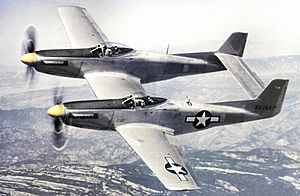Heavy fighter facts for kids

A heavy fighter is a historic category of fighter aircraft produced in the 1930s and 1940s, designed to carry heavier weapons, and/or operate at longer ranges than light fighter aircraft. To achieve performance, most heavy fighters were twin-engine, and many had multi-place crews; this was in contrast to light fighters, which were typically single-engine and single-crew aircraft. In Germany, they were known as Zerstörer ("destroyer").
The heavy fighter was a major design class during the pre-World War II period, conceived as long-range escort fighters or heavily-armed bomber destroyers. Most such designs failed in this mission, as they could not maneuver with the more conventional, single-engine fighters, and suffered heavy losses. Most notable among such designs was the Messerschmitt Bf 110, which suffered great losses during the Battle of Britain. An exception was the American Lockheed P-38 Lightning, which proved an effective heavy fighter; even against smaller, lighter, single-engine aircraft and particularly in the Pacific theater.
Many twin-engine heavy fighters found their niche as night fighters, especially in the bomber-destroyer role; or as fighter-bombers, roughly analogous to modern strike fighters. Among such conversions was the Bf 110, which served as a relatively successful night fighter, ground attacker, and fighter-bomber for most of the war; and the Bristol Beaufighter, which emerged as a major anti-shipping strike fighter of the Royal Air Force. Some heavy fighters did find success in the roles they were designed for; the de Havilland Mosquito, simultaneously developed as a light bomber, fighter and photo-reconnaissance aircraft, excelled in its originally-proposed role as a fast light bomber.
Although not always contemporaneously referred to explicitly as “heavy fighters,” nearly every single combatant of WWII fielded or experimented with twin-engine multi-role combat aircraft.
After World War II
Like other military types, piston-engine heavy fighters such as the de Havilland Hornet and Sea Hornet, as well as the North American F-82 Twin Mustang continued in service in the years immediately after the war. All were developed at the end of World War II for use in the Pacific theatre, though none reached operational squadrons until after VJ day, the Hornet in 1946, the Sea Hornet in 1947 and the Twin Mustang in 1948.

4th-generation and 5th-generation air superiority fighters are designed to wrest air superiority from the enemy in hostile territory, and thus usually have greater range than tactical fighters or interceptors. They therefore typically have two engines, and often carry a larger number of air-to-air missiles than their smaller brethren. They typically also have more capable and complex radar and electronic systems, with the result that in older air-superiority fighters such as the McDonnell Douglas F-4 Phantom II or Grumman F-14 Tomcat, a second dedicated crew member was carried to manage radar and weapon-systems.
Images for kids
-
A Messerschmitt Bf 110 in flight
See also
 In Spanish: Caza pesado para niños
In Spanish: Caza pesado para niños






